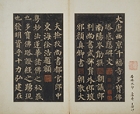Asian Gallery (Toyokan) Room 8
April 28, 2009 (Tue) - June 7, 2009 (Sun)
Yan Zhenqing (709-785) was born in Linyi, in the Langya region (present-day Shandong Province) of China, to a prestigious family of scholars traditionally specialized in linguistics and calligraphy. In 734 (Kaiyuan 22), during the reign of the Tang emperor Xuanzong, he passed the higher civil service examination at the age of 26, and served as a bureaucrat under four generations of emperors: Xuanzong, Suzong, Daizong, and Dezong. His style name was Qingchen, and was also known as Yan Pingyuan and Yan Lu Gong, due to his respective appointments as governor of Pingyuan and later, the duke of the Lu Region.
In 755 (Tianbao 14), when the An Lushan Rebellion erupted, Yan Zhenqing (then governor of Pingyuan) and his clan bravely formed an army and saved the Tang Dynasty from crisis even as the lords of Hebei Province surrendered. Zhenqing lost many relatives in this struggle, including a nephew who was beheaded by the insurgents. His "Draft Eulogy for a Nephew" is a renowned masterpiece that tells the intensity of his sorrow and anger at this incident. In 783 (Jianzhong 4), in the midst of another conspiracy, this time led by Li Xilie, Yan entered the hostile territory to convey imperial orders to Li, knowing all the while that this was part of a deceptive plan by the minister Lu Qi, and was trapped and killed at Longxing Temple in Caizhou, present-day Henan Province. He was 77 years old. His loyalty and courageousness were admired for times to come, and his calligraphy significantly influenced many later practitioners of the art.
Yan Zhenqing's masterpieces include "Draft Eulogy for a Nephew", "Draft Eulogy for an Uncle", and "Letter on Controversy over Seating Protocol", all written in running and cursive scripts, as well as many writings for steles in standard script. His standard script calligraphy is often described as starting smooth as the head of a silkworm, and ending swiftly as a swallowtail. Although based on the orthodox standard script established by his predecessors Ouyang Xun, Yu Shinan, and Chu Suiliang, his work is distinguished by a certain air of dignity, and his steles are each acclaimed as embodying unique senses of expression. Even in present times, Yan Zhenqing's writings are studied as ideal models of standard script. This exhibit, provides a comprehensive overview of his works to commemorate the 1300th anniversary of his birth.

